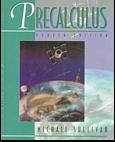Precalculus

|
Currently enrolled students login here
|
|
|
This info can also be downloaded in PDF format: Precalculus Course Description PDF
|
Description
This course will cover the topics normally covered in a high school pre-calculus course. This course is normally taken by students in grade eleven or twelve. Students should have completed Algebra 2 before enrolling in Pre-Calculus. A detailed course syllabus is shown below.
|
Fees
The cost of the course is $74 per month for nine months. Text, lecture notes, computer discs and any other instructional materials will be provided and will not cost extra. Lilburn Alliance Church charges a small fee ($25 per student per year) for use of the facility. Limited time for tutoring is also available for Algebra 1, Geometry, Algebra 2, Precalculus and Physics. Tutoring costs $30 per hour for students enrolled in a class, $45 per hour for others.
|
Lecture Notes and Class Time
Class time will primarily be spent on instruction. The lecture notes are a key part of the class. These notes are prepared in advance and given to the students, but with much of the material deleted and replaced by blank space on the page. During the lecture, the students fill in the gaps, solve the example problems, and add any notes they need to. By the end of the year, the students will have what amounts to their own complete text made from the lectures delivered and the problems worked in class. A sample of these lecture notes is in the PDF course description and under "Lecture Notes" on the menu of this web site.
|
Textbook
Precalculus by Michael Sullivan, 4th edition, published by Prentice Hall, 1996. This is an excellent text, known for its clarity. It has received many excellent reviews. The topics covered in this course will correspond closely to the topics covered in this book. Students will be assigned reading and practice problems from the textbook.
|
Homework, Tests and Grades
After each class, students will be given specific assignments to do on their own during the rest of the week. Assignments may consist of additional instructional material provided on CD or DVD and will almost always involve problems to practice. Some of the homework for each chapter will be graded. To allow for the maximum amount of instructional time in class, tests will be given at home. One final exam for each semester will be taken in class at the end of each semester. Students will receive a numerical grade for each semester and for the year. The grade is calculated based on tests, graded homework and the final exams.
|
Difficulty Level
Not all students require the same pace and difficulty level. Some may need or prefer a class that is more challenging and at a faster pace, while some may desire a class that is not accelerated. This class is offered simultaneously on two difficulty levels, regular and honors. The lectures are the same for both. The honors students will have additional homework that is more difficult, and will have more challenging tests. Note that the honors class is not an AP class. It is simply a more challenging version of the same course. The goal is for the classes to closely correspond to “Standard Precalculus" and “Honors Pre-Calculus" classes at a good private school. Students will decide whether they would prefer the standard or honors version of the course about a month into the course, after having had a chance to look at some tests and assignments.
|
Computer Access
Access to a computer (Windows or Macintosh) with a CD-ROM or DVD drive will be extremely helpful for this course. In addition to the lecture notes, students will be given instructional material on CD or DVD that will play on a home computer (not on a home DVD player). On the discs will be lectures (audio and video) that correspond to the lecture notes covered in class. These videos allow students to review the material, to hear the explanations again if needed, and to see example problems being worked out with detailed explanations. They also insure that the students receive all of the instruction, even if they miss a class. While a computer is not required for the class it will certainly be extremely helpful.
|
The Instructor
Derek Owens taught physics, honors physics, AP Physics, and AP computer science at The Westminster Schools in Atlanta, GA from 1988-2000. He currently teaches Physics in the summer school program at Westminster. He graduated from Duke University in 1988 with a degree in mechanical engineering and physics. He worked as a software developer for five years before returning to teaching. This will be his fourth school year teaching homeschoolers in the Atlanta area. He and his wife Amor and their two children Claire and David attend Grace Fellowship Church, a non-denominational church near their home in Lawrenceville.
|
Course Syllabus
These topics comprise the material normally taught in a first year high school algebra course.
- Chapter 1: Preliminaries
Review of topics from Algebra and Geometry; Equations; Setting Up Equations; Inequalities; Complex Numbers; Rectangular Coordinates and Graphs; Straight Lines
-
Chapter 2: Functions and Their Graphs
Functions; Graphing Techniques; Operations of Functions; Composite Functions; One-to-One Functions; Inverse Functions; Mathematical Models
-
Chapter 3: Polynomial and Rational Functions
Quadratic Functions; Polynomial Functions; Rational Functions; Synthetic Division; Zeros of Polynomial Functions; Approximating Real Zeros; Complex Polynomials; The Fundamental Theorem of Algebra;
-
Chapter 4: Exponential and Logarithmic Functions
Exponential Functions and Graphs; Logarithmic Functions and Graphs; Properties of Logarithms; Exponential and Logarithmic Equations; Compound Interest; Growth and Decay; Logarithmic Scales
-
Chapter 5: Trigonometric Functions
Radian and Degree Measure; The Unit Circle; Properties of Trigonometric Functions; Right Triangle Trigonometry; Applications
-
Chapter 6: Graphs of Trigonometric Functions
Graphs of the Sine and Cosine Functions; Sinusoidal Graphs; Applications; Graphs of Tangent, Cosecant, Secant, and Cotangent Functions; Inverse Trigonometric Functions
-
Chapter 7: Analytic Trigonometry
Trigonometric Identities; Sum and Difference Formulas; Double-angle and Half-angle Formulas; Product-to-Sum and Sum-to-Product Formulas; Trigonometric Equations
-
Chapter 8: Additional Applications of Trigonometry
The Law of Sines; The Law of Cosines; The Area of a Triangle; Polar Coordinates; Polar Equations and Graphs; The Complex Plane: DeMoivre’s Theorem
-
Chapter 9: Analytic Geometry
The Parabola; The Ellipse; The Hyperbola; Rotation of Axes: General Form of a Conic; Polar Equations of Conics; Plane Curves and Parametric Equations
-
Chapter 10: Systems of Equations and Inequalities
Solving Systems of Equations by Substitution and Elimination; Matrices; Determinants; Systems of Nonlinear Equations; Systems of Inequalities; Linear Programming
-
Chapter 11: Sequences, Induction, Counting, and Probability
Sequences; Arithmetic Sequences; Geometric Sequences and Series; Mathematical Induction; The Binomial Theorem; Counting Principles; Permutations and Combinations; Probability
-
Chapter 12: Miscellaneous Topics
Matrix Algebra; Partial Fraction Decomposition; Vectors; The Dot Product
|
